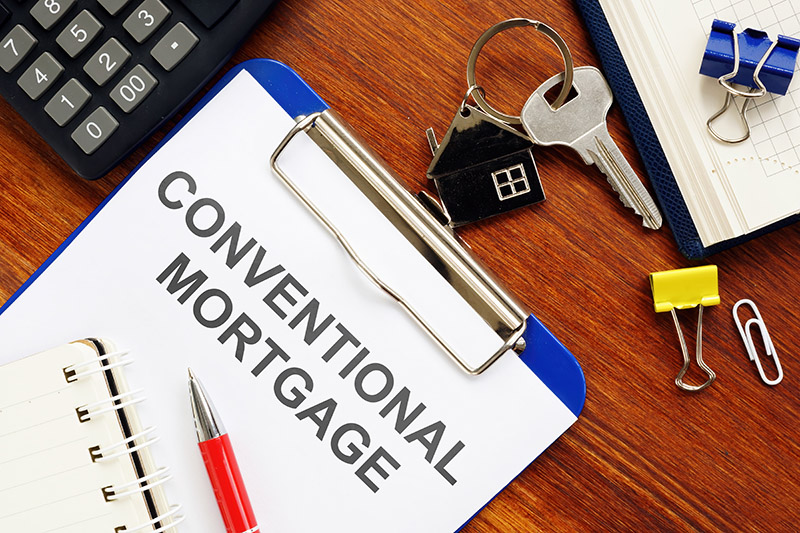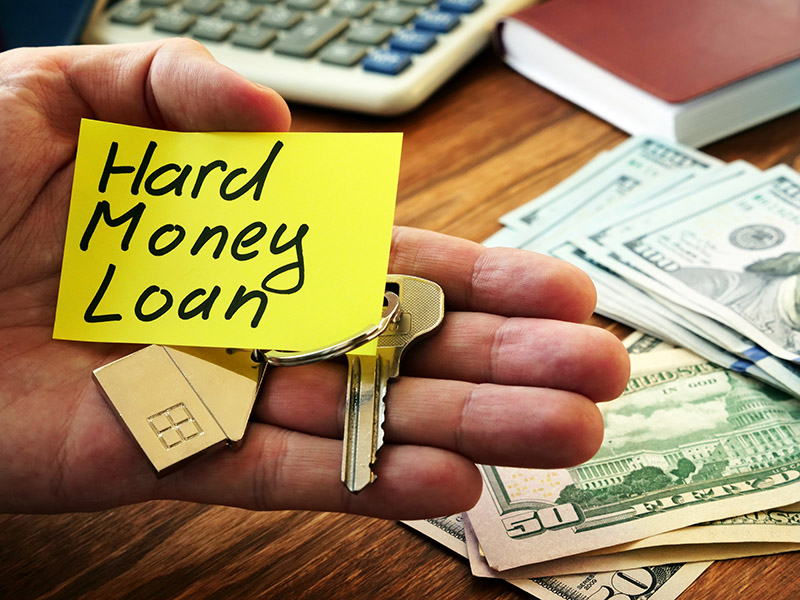B Real Capital offers competitive rates on a variety of home loan options.

Conventional Loans
3% Down Payment Mortgages for First-Time Home Buyers.
What Is A Conventional Loan?
Conventional loans are the most popular mortgage for home purchases and refinances. A conventional mortgage loan is a “conforming” loan, which simply means that it meets the requirements for Fannie Mae or Freddie Mac. Fannie Mae and Freddie Mac are government-sponsored enterprises that purchase mortgages from lenders and sell them to investors.
Conventional Loan Requirements:
- Down Payment - It’s possible for first-time home buyers to get a conventional mortgage with a down payment as low as 3%. However, the down payment requirement can vary based on your personal situation and the type of loan or property you’re getting:
- 5% down payment for repeat home buyers and those who earn less than 80% of the area median income.
- If the house you’re buying is not a single-family home (i.e., it has more than one unit), you may need to put down 15%.
- If you’re buying a second home, you’ll need to put at least 10% down.
- If you’re getting an adjustable-rate mortgage, the minimum down payment requirement is 5%.
- Down Payment - It’s possible for first-time home buyers to get a conventional mortgage with a down payment as low as 3%. However, the down payment requirement can vary based on your personal situation and the type of loan or property you’re getting:
If you’re refinancing a conventional loan, you’ll need more than 3% equity. In all cases, you’ll need at least 5% equity. If you’re doing a cash-out refinance, you’ll need to leave at least 20% equity in the home.
- Private Mortgage Insurance - If you put down less than 20% on a conventional loan, you’ll be required to pay for private mortgage insurance (PMI). PMI protects your mortgage investors in case you default on your loan. The cost for PMI varies based on your loan type, your credit score and the size of your down payment. When you reach 20% equity in the home on your regular mortgage payment schedule, you can ask your lender to remove the PMI from your mortgage payments.
- If you reach 20% equity as a result of your home increasing in value, you can contact your lender for a new appraisal so they can use the new value to recalculate your PMI requirement. Once you reach 22% equity in the home, your lender will automatically remove PMI from your loan.
- Credit Score: In most cases, you’ll need a credit score of at least 620 to qualify for a conventional loan. When you apply, your lender will check your credit history to determine if you have good credit.
- Debt-to-Income Ratio: Your debt-to-income ratio (DTI) is a percentage that represents how much of your monthly income goes to pay off debts. You can calculate your DTI by adding up the minimum monthly payments on all your debts (like student loans, auto loans and credit cards) and dividing it by your gross monthly income. For most conventional loans, your DTI must be 50% or lower.
- Loan size: For a conforming conventional loan, your loan must fall within the loan limits set by Fannie Mae and Freddie Mac. The loan limit changes annually. For 2022, the conforming loan limit for a single-family home is $726,200.
Non QM Programs
For Non-Traditional Borrowers - No Foreign or U.S. credit needed.
Non QM Programs
Simple Access Minimum 20-25 % Down Payment:
Borrower’s tax returns don’t tell the whole story sometimes. There are multiple options to calculate the borrower’s net qualifying income to make qualifying easy!
- 12 – 24 Bank Statements Individual & Company
Asset Qualifier:
Program based on their liquid assets or assets that can be liquidated without any restrictions. No income or employment needs to be verified. Typical borrowers who would take advantage of this program would have sizable assets, but don’t have sufficient income from regular employment sources.
- 12 – 24 Bank Statements Individual & Company
Simple Access:
1099 Only: This program is for Borrowers who are paid in the form of commissions or as an independent contractor and receive 1099(s).
P&L Statement Only: This program relies on unaudited profit & loss statement(s) in conjunction with a minimum of 2 months business bank statements to determine qualifying income.
Fully Documented: The Full Doc program is typically used in situations where a borrower has had a recent major derogatory credit event and doesn’t qualify for other more mainstream loan programs. There are reduced documentation options available based on the borrower’s situation, including a 1-year tax return or a 1-year W-2 option for qualified borrowers.
Foreign National Program:
This mortgage product is for foreign nationals wanting to purchase or refinance a home in the United States.
- LTV: 80% for Single Family Residences - 75% for Condos (may vary)
- Prepayment Penalties are 3% first year; 2% second year and 1% third year. A partial principal reduction of 20% of the original balance is allowable with no penalty.
- 3/1 ARMs, 5/1 ARMs, 7/1 ARMs (Fully Amortizing)
- 30 Year Fixed Rates
- Interest Only Options: (Non TRID Non QM Loans – 3/1 & 5/1 ARMs)
- Loan Requirements:
- Self-employed Foreign National borrowers require a letter from an Accountant/Auditing firm (not connected with borrower or borrower’s business), verifying income figures for the last two years and providing a year to date income figure. It helps if the business has a website. If not, please provide printed business materials or brochures. In some we may request additional reference letters from companies, which borrower have worked in the past with.
- Salaried employees must provide a letter from the employer stating their current monthly salary or a valid pay stub.
- One letter of reference from a banking or financial institution, showing at least 24 months history and relationship status. Borrower must have enough money to maintain payments in U.S. and lifestyle in the home country. The borrower’s liquid asset position must be commensurate with the borrower’s financial statement and income level.
- Two Utility bills or any document from a home country, which contains borrower's name and address (to prove residency in the country he/she lives).
- Copy of borrower’s passport and visa (when applicable).
- Borrower must set up an Auto Payment Debit Account with a US banking institution, which will allow the bank to withdraw monthly mortgage payments automatically.


Hard Money Loans & DSCR Loans [No-Doc Rental Loan]
Easy to do and quick to close for those who are eligible.
Hard Money Loans & DSCR Loans
[No-Doc Rental Loan]
The Easiest Way to Finance Your Investment Property. Unlike traditional loans that rely on tax returns, pay stubs, and W2's, our DSCR rental loans focus on the property's cash flow. We assess the property’s ability to generate rental income that covers its expenses, known as the debt service coverage ratio (DSCR). With a DSCR rental loan, we require a minimum DSCR level, typically 1.1, ensuring your investment's success.
Loan Requirements :
- Last 2 or 3 month Bank Statements
- Driver’s License & Passport
- Single Family Residences – 20 % Down Payment
- Condos – 25% Down Payment
- Assets sourced and seasoned for 60 days – must be in a U.S. FDIC insured bank for a minimum of 30 days.
- 4, 6 months reserves required and must be in a U.S. bank.
- ACH auto-payment is required and form must be completed at closing.
- Must have an eligible Visa: B-1, B-2, H-2, H-3, I, J-1, J-2, O-2, P1, P2
Here's how it works:
- We evaluate your property's cash flow and market rent, determined through an appraiser's market rent survey. (Form 1007)
- The DSCR equation is calculated as Rents / PITI + HOA Dues.
- For example, your rental income is $5,000 per month and your mortgage payment, taxes, and insurance total up to $4,000. In this scenario, you’d have a DSCR well above 1.1, thereby qualifying you for your DSCR rental loan.
Why Choose a DSCR Rental Property Loan?
DSCR rental loans can be used to finance the purchase or refinance of a variety of rental properties, including single family residence, condominium, townhome, and 2-4 units. They can be a useful financing option for real estate investors who are looking to generate income from their investment properties.
Hard Money Loans are designed for property investors who need quick access to capital at competitive interest rates. The entire application process can be completed online, in less than 5 minutes. Instant Proof of Funds Letter. Instant Approval – 7 Days Close
A hard money loan is a short-term, non-conforming loan for commercial or investment properties, that doesn’t come from traditional lenders, but rather people or private companies that accept property or an asset as collateral. The “hard” part of “hard money” refers to the tangible asset being used to back the value of the loan. Hard money loans can have much higher interest rates, often 8 – 12%.
Hard Money Loan Pros
- Faster approval process
- Approval based on property, not credit history
- More flexible
- Less strict underwriting
- The opportunity to fix and flip properties
The drawbacks of hard money loans include:
- High interest rates
- Often require large down payments
- Shorter terms mean less time to repay
- Riskier than traditional financing
- May require a track record of successful house flips
Construction, Land Loans & Fix-&-Flip
What You Need To Know
Construction, Land Loans & Fix-&-Flip
Construction loans are short-term loans that you can use to build a new home. There are several types of construction loans, including construction-to-permanent and construction-only loans. Depending on your construction loan type, you may be able to convert it to a mortgage after your home is finished. Funds borrowed are typically released in a series of advances (or “draws”) to pay for expenses as the building is being constructed.
Loan Requirements:
- As Built Survey Approved
- Construction Contract
- List of Materials & Contract
- Sub-Contracts (if applicable)
- Construction Cost Estimates
- Hard Costs
- Soft Costs
- Interior Unit Build-Costs
- Breakdown Stages (Disbursement)
- Contractor Information
How to Qualify for a Home Construction Loan
To qualify for a construction loan, a lender will typically look at two key factors: your credit scores and debt-to-income ratio (DTI). Our guidelines look for a minimum credit score of 620 or higher with a record of making timely payments along with a good DTI.
What Are the Benefits of Building a Home?
As long as you stay within your budget and comply with community building regulations, building your own home allows you to personalize the structure to your specific tastes in ways beyond buying an existing home: from the architectural style to the interior floor plan and from the color schemes to the lighting, and much more.
Can You Get a Loan for Land and Building a House?
When you apply for a home construction loan, the house only exists as an idea. In fact, you may not even have a piece of land in your name. So, as part of the process, you’ll either need to purchase a lot or have a purchase agreement for the lot you plan to buy and build upon. Lot selection is crucial for many reasons, including the obvious one: this property determines where you’ll build your new home, your neighborhood, the surrounding community, and ultimately, where you’ll live.
- Lot location: If you enjoy living in the midst of hustle and bustle, it’s a good idea to choose a lot where you’re close to dining, shopping, and recreational venues. If you prefer tranquility, consider a lot in a more natural setting with trees. If you’re looking for a quieter lifestyle, check with your local government to see what future growth plans exist for your area of choice. Are you responsible for adding any utility-related features? Do you have clear road access?
- Lot status: Investigate how ready the lot is for building. Some are build-ready, which means utilities and other services are in place for that lot. Others are still unimproved, which means that you’ll need to wait for basic services to be established before building upon that piece of property. The wait may be short—or it may not. Factor that into your lot selection.
- Land survey: Get the land surveyed to have a clear understanding of your exact boundaries and see what easements exist. An easement may exist because of a neighbor’s driveway or because of an underground utility or power line. No matter why an easement is in place, it means that someone else has a specifically-defined limited use of that portion of your property. Is that easement acceptable to you? If not, consider another piece of land.
- Zoning ordinances: Learn what zoning ordinances are in place for your chosen lot and whether this property will fall within a homeowners association (HOA). If it does, make sure you’re comfortable with the HOA fees and restrictions, and get a clear understanding of the benefits you’ll receive as an HOA member.
- Flood insurance: Find out if you’ll need to purchase flood insurance because of the lot’s location on a flood plain. Also, investigate the flood insurance cost, which will be above and beyond regular homeowners insurance, and include features you’ll need, such as hurricane shutters, in your building plans.
Comparing Construction Companies
First, you’ll need to choose a builder and then present the lender with specific plans for the home before applying for a construction loan. These will include blueprints, a detailed cost estimate for the home’s construction, and a contract with your builder that lists how much you’ll be charged for construction.
To find the right builder, be sure to reach out to friends and family members who have used a contractor (preferably to build a new home and renovations). Some questions to consider asking them: if they were satisfied with the work done, if they met deadlines according to the timetable, and if the person and company were easy to work with, along with other questions you may have. You can also check your Better Business Bureau (BBB) and reviews online or in social media groups, and through this process, create a list of potential contractors.
Fix & Flip
Funds for purchase + rehab or refinance + rehab. A fix and flip loan is short-term financing that real estate investors use to buy and renovate a property in order to resell it for a profit, a process known as house flipping. This form of financing can benefit investors trying to make a profit flipping homes.
Loan Requirements:
- Up to 85% of property purchase amount
- 100% financing on rehab costs
- No interest charged on unused rehab funds
- 12-Month interest only (no prepayment penalty)
- Up to 75% ARV


Commercial Real Estate Loans - Non Recourse
Commercial Real Estate (CRE) is income-producing property used solely for business (rather than residential) purposes.
Commercial Real Estate Loans - Non Recourse
Commercial real estate (CRE) is income-producing property used solely for business (rather than residential) purposes. Examples include retail malls, shopping centers, office buildings and complexes, and hotels. Financing—including the acquisition, development, and construction of these properties—is typically accomplished through commercial real estate loans: mortgages secured by liens on the commercial property. In contrast to residential real estate, commercial real estate is focused on income generation. Commercial real estate loans typically have a shorter term than traditional residential homes.
B Real Capital…We Care. We Get You. We Guide You.
Realtors…It’s All About You.
